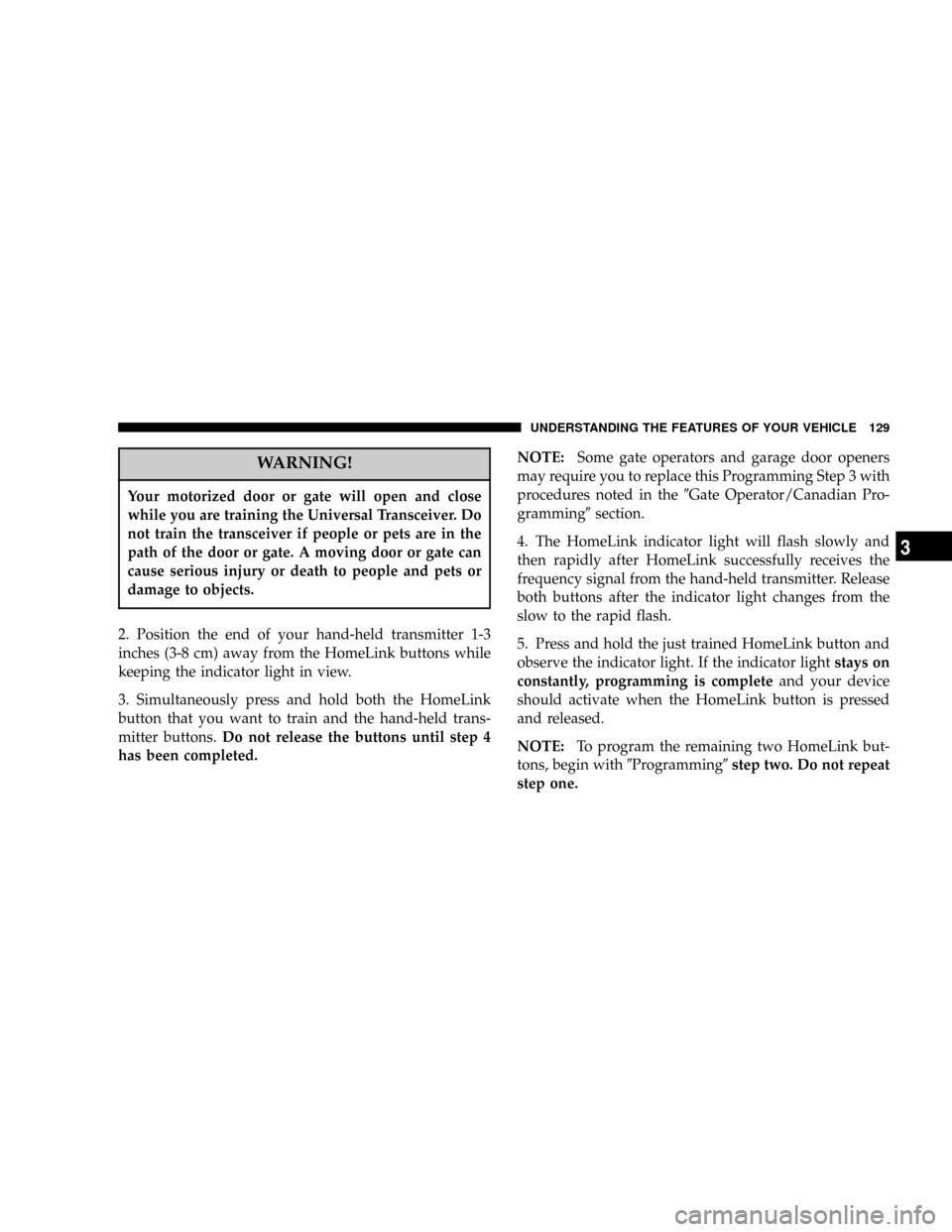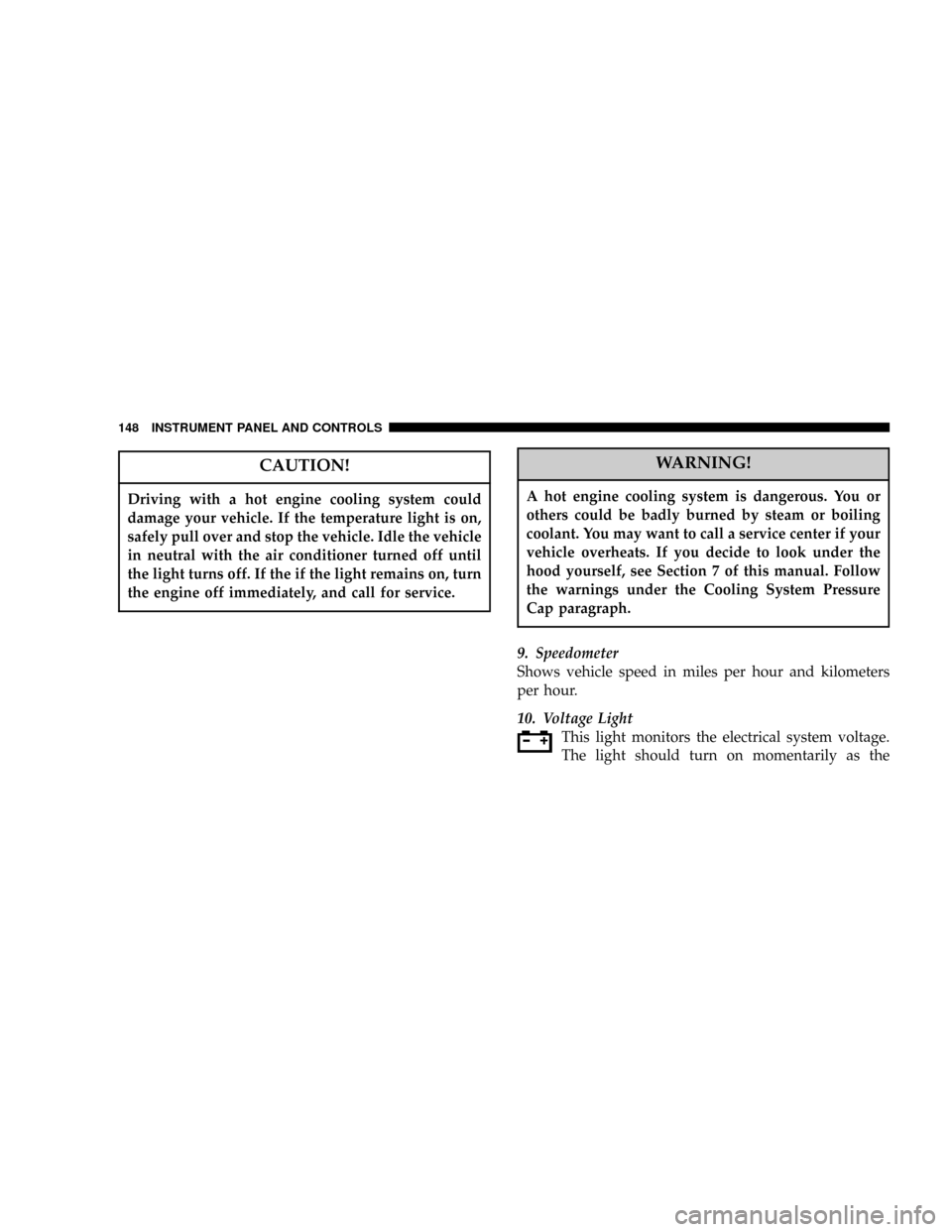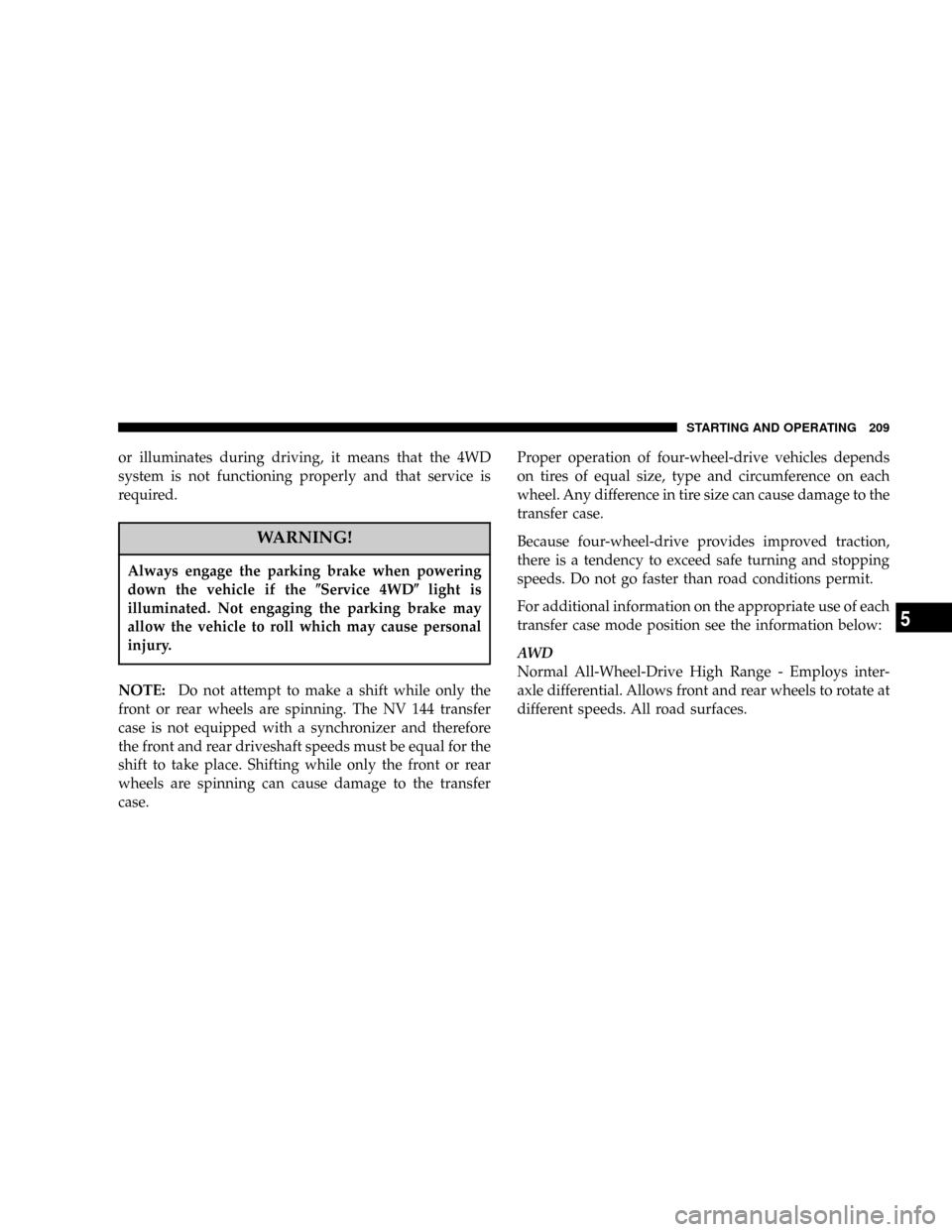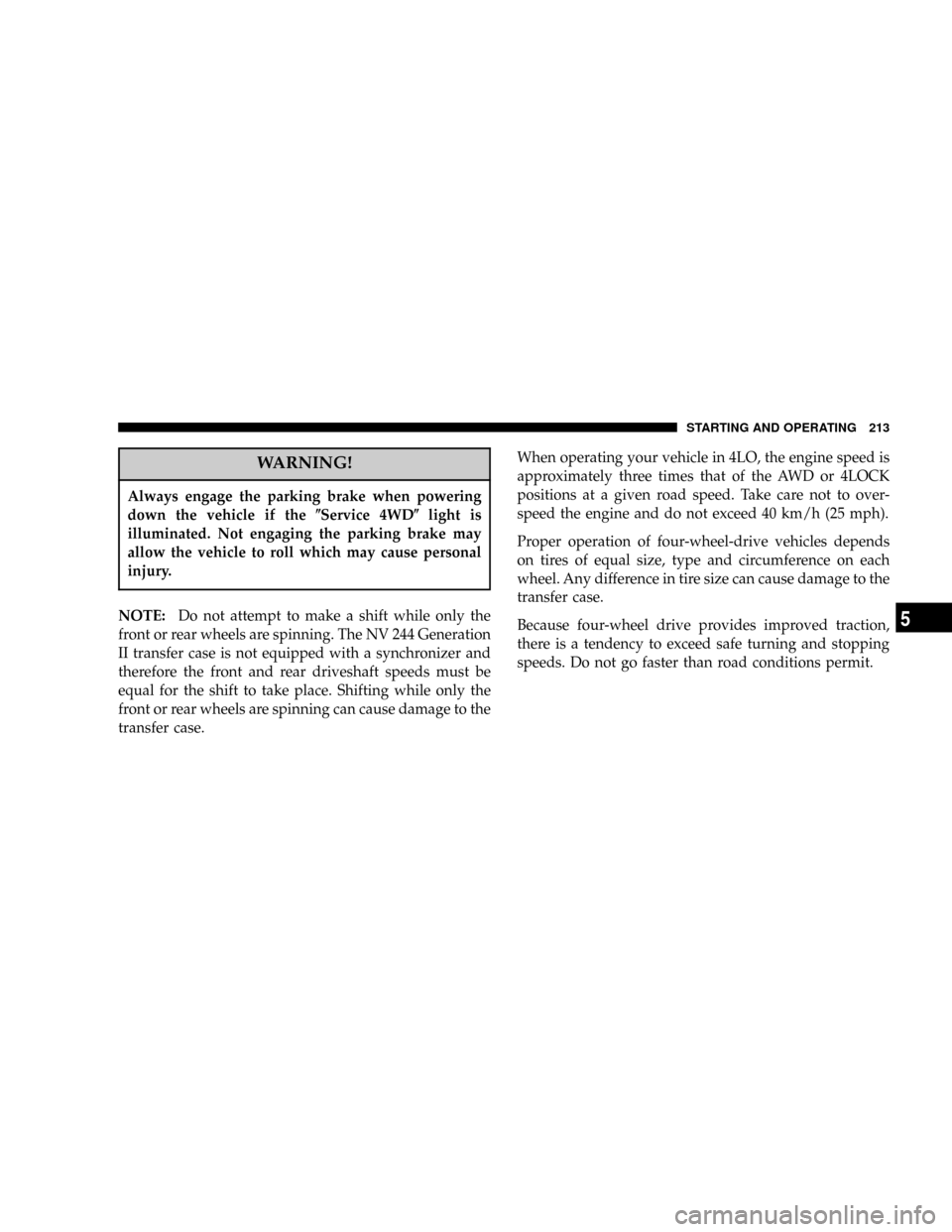warning light DODGE DURANGO 2004 2.G User Guide
[x] Cancel search | Manufacturer: DODGE, Model Year: 2004, Model line: DURANGO, Model: DODGE DURANGO 2004 2.GPages: 386, PDF Size: 6.22 MB
Page 128 of 386

Programming HomeLink
NOTE:When programming a garage door opener, it is
advised to park outside the garage. It is also recom-
mended that a new battery be placed in the hand-held
transmitter of the device being programmed to
HomeLink for quicker training and accurate transmis-
sion of the radio-frequency signal.
1. Press and hold the two outer HomeLink buttons, and
release only when the indicator light begins to flash (after
20 seconds).Do nothold the buttons for longer than 30
seconds anddo notrepeat step one to program a second
and/or third hand-held transmitter to the remaining two
HomeLink buttons.
WARNING!
Vehicle exhaust contains carbon monoxide, a danger-
ous gas. Do not run the vehicle's exhaust while
training the transceiver. Exhaust gas can cause seri-
ous injury or death.
128 UNDERSTANDING THE FEATURES OF YOUR VEHICLE
Page 129 of 386

WARNING!
Your motorized door or gate will open and close
while you are training the Universal Transceiver. Do
not train the transceiver if people or pets are in the
path of the door or gate. A moving door or gate can
cause serious injury or death to people and pets or
damage to objects.
2. Position the end of your hand-held transmitter 1-3
inches (3-8 cm) away from the HomeLink buttons while
keeping the indicator light in view.
3. Simultaneously press and hold both the HomeLink
button that you want to train and the hand-held trans-
mitter buttons.Do not release the buttons until step 4
has been completed.NOTE:Some gate operators and garage door openers
may require you to replace this Programming Step 3 with
procedures noted in the9Gate Operator/Canadian Pro-
gramming9section.
4. The HomeLink indicator light will flash slowly and
then rapidly after HomeLink successfully receives the
frequency signal from the hand-held transmitter. Release
both buttons after the indicator light changes from the
slow to the rapid flash.
5. Press and hold the just trained HomeLink button and
observe the indicator light. If the indicator lightstays on
constantly, programming is completeand your device
should activate when the HomeLink button is pressed
and released.
NOTE:To program the remaining two HomeLink but-
tons, begin with9Programming9step two. Do not repeat
step one.
UNDERSTANDING THE FEATURES OF YOUR VEHICLE 129
3
Page 147 of 386

left/right turn signal is left on with the engine RPM
vehicle speed greater than 15 mph (24 km/h) for more
than one mile.
4. Low Fuel Warning Light
This indicator lights when the fuel gauge reads 1/8
of a tank or less.
5. High Beam Indicator
Indicates that headlights are on high beam.
6. Seat Belt Reminder Light
This light comes on for several seconds after the
ignition is turned ON as a reminder to ªbuckle
up.º This light will remain on as long as the seat
belt remains unbuckled. If this light flashes, it indicates a
fault in the airbag system. Have the system checked by
an authorized dealer.7. Fog Light Indicator Ð If Equipped
This light shows when the fog lights are ON.
8. Coolant Temperature Light
This light warns of an overheated engine condi-
tion. For a bulb check, this light will come on
momentarily when the ignition is turned On. If the
light turns on while driving, stop the vehicle, shift into N
(Neutral) and increase the engine speed for 2 to 3
minutes. If the temperature reading does not return to
normal, seek authorized service immediately.
INSTRUMENT PANEL AND CONTROLS 147
4
Page 148 of 386

CAUTION!
Driving with a hot engine cooling system could
damage your vehicle. If the temperature light is on,
safely pull over and stop the vehicle. Idle the vehicle
in neutral with the air conditioner turned off until
the light turns off. If the if the light remains on, turn
the engine off immediately, and call for service.
WARNING!
A hot engine cooling system is dangerous. You or
others could be badly burned by steam or boiling
coolant. You may want to call a service center if your
vehicle overheats. If you decide to look under the
hood yourself, see Section 7 of this manual. Follow
the warnings under the Cooling System Pressure
Cap paragraph.
9. Speedometer
Shows vehicle speed in miles per hour and kilometers
per hour.
10. Voltage Light
This light monitors the electrical system voltage.
The light should turn on momentarily as the
148 INSTRUMENT PANEL AND CONTROLS
Page 149 of 386

engine is started. If the light stays on or turns on while
driving, it indicates a problem with the charging system.
Immediate service should be obtained.
11. Liftgate Open
The Gate Open light will illuminate when the liftgate is
not properly closed and the ignition is ON.
12. Security Light
This light will flash rapidly for approximately 15 seconds
when the vehicle theft alarm is arming. The light will
flash at a slower speed continuously after the alarm is set.
The security light will also come on for about three
seconds when the ignition is first turned on.
13. ABS Warning Light
This light monitors the Anti-Lock Brake System
which is described elsewhere in this manual.
This light will come on when the ignition key is
turned to the ON position and may stay on for
approximately 3 seconds. If this light remains on orcomes on during driving, it indicates that the Anti-Lock
portion of the brake system is not functioning and that
service is required. See your authorized dealer immedi-
ately.
14. Engine Oil Pressure Indicator Light
This light indicates that the engine oil pressure has
become too low. For a bulb check, this light will
come on momentarily when the ignition is turned On. If
the light turns on while driving, stop the vehicle and shut
off the engine as soon as possible. Immediate service
should be obtained.
15. Tachometer
This gage measures engine revolutions-per-minute (rpm
x 1000).
16. Gear Selector
The electronic gear selector display is self-contained
within the instrument cluster. It displays the position of
the automatic transmission shift lever, and the relation of
INSTRUMENT PANEL AND CONTROLS 149
4
Page 151 of 386

NOTE:Extended heavy use of Traction Control may
cause the system to deactivate and turn on the Traction
Control indicator. This is to prevent overheating of the
brake system and is a normal condition. The system will
remain disabled for about 4 minutes until the brakes have
cooled. The system will automatically reactivate and turn
off the Traction Control indicator.
19. Transmission Temperature Indicator
This light indicates that there is excessive transmission
fluid temperature that might occur with severe usage
such as trailer towing. If this light comes on, stop the
vehicle and run the engine at idle or faster, with the
transmission in NEUTRAL until the light goes off.
20. Electronic Throttle Control (ETC) Light 5.7L
Engines Only
This light informs you of a problem with the
Electronic Throttle Control system. If a prob-
lem is detected the light will come on while theengine is running. If the light remains lit with the engine
running your vehicle will usually be drivable, however,
see your dealer for service as soon as possible. If the light
is flashing when the engine is running, immediate service
is required and you may experience reduced perfor-
mance, an elevated/rough idle or engine stall and your
vehicle may require towing. The light will come on when
the ignition is first turned on and remain on briefly as a
bulb check. If the light does not come on during starting,
have the system checked by an authorized dealer.
21. Door Ajar
The Door Ajar light will illuminate when the ignition is
ON and any one of the passenger doors are opened.
NOTE:A chime will sound if the vehicle is rolling and
a door has been opened.
22. BRAKE System Warning Light
This light will light when the ignition key is turned to the
ON position and will remain on for a few seconds. If the
INSTRUMENT PANEL AND CONTROLS 151
4
Page 208 of 386

transmission into gear may seem sluggish. This is due to
the fluid partially draining from the torque converter into
the transmission. This condition is normal and will not
cause damage to the transmission. The torque converter
will refill within five seconds of shifting from Park into
any other gear position.
FOUR-WHEEL DRIVE OPERATION
NV 144 Transfer Case Operating
Information/Precautions
The NV 144 is an electric shift transfer case and is
operated by the Four-Wheel-Drive (4WD) Control
Switch, which is located on the instrument panel.
The NV 144 transfer case provides 2 mode positions:
All-Wheel Drive (AWD) and 4-Wheel-Drive LOCK.
The NV 144 transfer case is designed to be driven in for
AWD for normal street and highway conditions (all road
surfaces roads).When additional traction is required, the transfer case
4LOCK position can be used to lock the front and rear
driveshafts together and force the front and rear wheels
to rotate at the same speed. This is accomplished by
rotating the 4WD Control Switch to the 4LOCK position
- see Shifting Procedure section for specific shifting
instructions. The 4LOCK position is designed for loose,
slippery road surfaces only. Driving in the 4LOCK posi-
tion on dry hard surfaced roads may cause increased tire
wear and damage to the driveline components.Transfer Case Position Indicator Lights
Transfer case position indicator lights are located on the
instrument cluster, and indicate the current and desired
transfer case selection. If there are no indicator lights on
or flashing the transfer case position is All-Wheel Drive
(AWD).
The ªSVC 4WDº warning light monitors the electric shift
4WD system. If this light remains on after engine start up
208 STARTING AND OPERATING
Page 209 of 386

or illuminates during driving, it means that the 4WD
system is not functioning properly and that service is
required.
WARNING!
Always engage the parking brake when powering
down the vehicle if the(Service 4WD(light is
illuminated. Not engaging the parking brake may
allow the vehicle to roll which may cause personal
injury.
NOTE:Do not attempt to make a shift while only the
front or rear wheels are spinning. The NV 144 transfer
case is not equipped with a synchronizer and therefore
the front and rear driveshaft speeds must be equal for the
shift to take place. Shifting while only the front or rear
wheels are spinning can cause damage to the transfer
case.Proper operation of four-wheel-drive vehicles depends
on tires of equal size, type and circumference on each
wheel. Any difference in tire size can cause damage to the
transfer case.
Because four-wheel-drive provides improved traction,
there is a tendency to exceed safe turning and stopping
speeds. Do not go faster than road conditions permit.
For additional information on the appropriate use of each
transfer case mode position see the information below:
AW D
Normal All-Wheel-Drive High Range - Employs inter-
axle differential. Allows front and rear wheels to rotate at
different speeds. All road surfaces.
STARTING AND OPERATING 209
5
Page 212 of 386

vehicle in the 4LOCK position on dry hard surfaced
roads. This feature provides the safety, security, and
convenience of operating in all-wheel drive at all times
regardless of road conditions.
When additional traction is required, the 4LOCK and
4LO positions can be used to lock the front and rear
driveshafts together through the transfer case inter-axle
differential and force the front and rear wheels to rotate
at the same speed. This is accomplished by rotating the
4WD Control Switch to these positions. The 4LOCK and
4LO positions are intended for loose, slippery road
surfaces only. Driving in the 4LOCK and 4LO positions
on dry hard surfaced roads may cause increased tire wear
and damage to the driveline components.
The transfer case Neutral (N) position is selected by
depressing the recessed button located on the lower left
hand corner of the 4WD Control Switch.NOTE:The transfer case Neutral (N) position is to be
used for recreational towing only. See Recreational Tow-
ing section for specific procedures on shifting into and
out of Neutral (N).
Transfer Case Position Indicator Lights
Transfer case position indicator lights are located on the
instrument cluster. If there are no indicator lights on or
flashing the transfer case position is All-Wheel Drive
(AWD) and indicate the current and desired transfer case
selection (4HI,4LOCK).
The ªSVC 4WDº warning light monitors the electric shift
4WD system. If this light remains on after engine start up
or illuminates during driving, it means that the 4WD
system is not functioning properly and that service is
required.
212 STARTING AND OPERATING
Page 213 of 386

WARNING!
Always engage the parking brake when powering
down the vehicle if the(Service 4WD(light is
illuminated. Not engaging the parking brake may
allow the vehicle to roll which may cause personal
injury.
NOTE:Do not attempt to make a shift while only the
front or rear wheels are spinning. The NV 244 Generation
II transfer case is not equipped with a synchronizer and
therefore the front and rear driveshaft speeds must be
equal for the shift to take place. Shifting while only the
front or rear wheels are spinning can cause damage to the
transfer case.When operating your vehicle in 4LO, the engine speed is
approximately three times that of the AWD or 4LOCK
positions at a given road speed. Take care not to over-
speed the engine and do not exceed 40 km/h (25 mph).
Proper operation of four-wheel-drive vehicles depends
on tires of equal size, type and circumference on each
wheel. Any difference in tire size can cause damage to the
transfer case.
Because four-wheel drive provides improved traction,
there is a tendency to exceed safe turning and stopping
speeds. Do not go faster than road conditions permit.
STARTING AND OPERATING 213
5